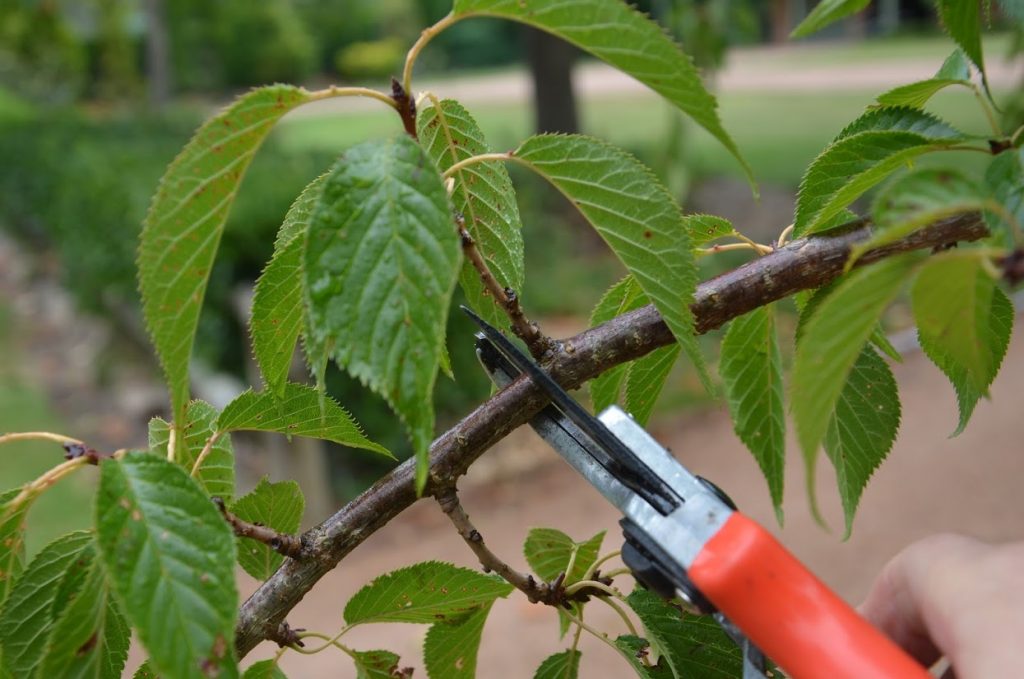
Here is a quick overview of the basic pruning requirements for the most common cool climate fruit trees.
You can read my other posts on Pruning Fruiting Trees and Pruning: Equipment Needed here.
It is always a good idea to have someone show you how to prune and point out what is fruiting wood/buds and what are vegetative buds. If this is not possible check out some of the video links at the end of this blog.
Almond. Fruit on semi-permanent spurs or sprigs. Best pruned during summer. Prune for general health and to manage size. The removal of one structural branch per year will ensure continued tree vigour.
Apricots. Fruit on one-year-old wood and semi-permanent sprigs. Best pruned after harvest or early autumn to reduce incidence of bacterial canker. Prune to promote new growth.
Apples and pears. Fruit on non-vigorous laterals, spurs and lateral tips that are at least two years old and growing horizontally. All varieties bear the best fruit on two-year and older wood. Best pruned in summer for maintenance, to encourage spur production or thin out older non-productive spurs.
Winter prune if the tree needs to rejuvenate, which will produce vigorous upright lateral which can be pruned the following summer to promote spur production. Where necessary remove weakened laterals to encourage more vigorous ones to develop spurs. Avoid tip-pruning young fruiting laterals as this promotes overcrowding which spoils the vase shape.
Cherries. Fruit on one-year-old wood and spur. Once established require little pruning so pruning should be for health maintenance of height and structural framework.
Peaches and nectarines. Fruit on one-year-old wood. Can be pruned in either late summer after harvest or in winter. They require heavy annual pruning. Prune back hard to a fruiting buds, keeping fruiting wood close to main framework to reduce branch bending and breakage when heavy with fruit. Prune to promote new lateral growth from main branches.
Plums: European. Fruit on one-year-old wood, older wood and spurs, with the heaviest production on 2-year-old wood. Can be pruned in either late summer after harvest or in winter. Plums tend to flower profusely leading to heavy cropping which can lead to branch breakage. Need to prune back to keep fruit close to main framework. Best to reduce all new shoot back by two thirds.
Japanese plums. Fruit on one-year-old wood Can be pruned in either late summer after harvest or in winter and need to have their new growth reduced by at least a half each year.
Citrus. Only require pruning for maintenance of health, height and shape. Best pruned in autumn.
Kiwi fruit. Fruit on growth arising from buds at the base (last six buds) of previous season growth. Best pruned in winter. Cut back all previous seasons long canes to leave six buds.
Figs. Figs normally bear two crops a year. The early, light crop is borne on the previous year’s wood; the main crop is borne on the current season’s wood. To avoid decreasing fruit production, restrict pruning to lightly thinning excessive growth. Tip-prune selected old leaders to promote fruiting wood. Spreading trees may require occasional attention to maintain a compact framework. Prune large branches back to shooting wood after the March harvest. Avoid cutting into barren wood with no leaf shoots.
Mulberries.Mulberries do not normally require pruning. If necessary, prune in winter. Remove occasional old, overcrowded, thick laterals.
Here are some useful resources and videos that will help you become a confident fruit tree pruner.
https://www.flemings.com.au/wp-content/uploads/2015/07/pruning_multi_page.pdf
https://www.dpi.nsw.gov.au/agriculture/horticulture/citrus/content/crop-management/orchard-management-factsheets/pruning-videos
https://www.abc.net.au/local/videos/2009/09/09/2680701.htm
https://www.abc.net.au/local/videos/2009/09/08/2680016.htm?site=local
https://www.abc.net.au/local/videos/2009/06/23/2606206.htm?site=local
https://www.abc.net.au/local/videos/2011/08/02/3283626.htm?site=local